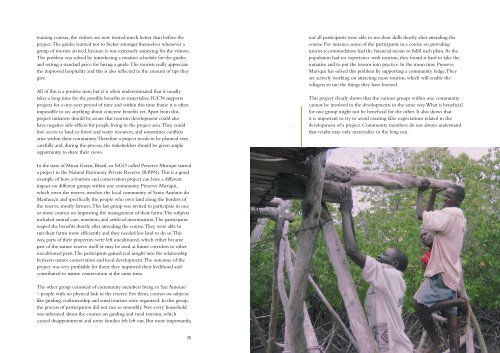OMSLAG 5.indd - IUCN
OMSLAG 5.indd - IUCN
OMSLAG 5.indd - IUCN
You also want an ePaper? Increase the reach of your titles
YUMPU automatically turns print PDFs into web optimized ePapers that Google loves.
training courses, the visitors are now treated much better than before the<br />
project. The guides learned not to bicker amongst themselves whenever a<br />
group of tourists arrived, because it was extremely annoying for the visitors.<br />
The problem was solved by introducing a rotation schedule for the guides<br />
and setting a standard price for hiring a guide. The tourists really appreciate<br />
the improved hospitality and this is also reflected in the amount of tips they<br />
give.<br />
All of this is a positive start, but it is often underestimated that it usually<br />
takes a long time for the possible benefits to materialize. <strong>IUCN</strong> supports<br />
projects for a one-year period of time and within this time frame it is often<br />
impossible to say anything about concrete benefits yet. Apart from this,<br />
project initiators should be aware that tourism development could also<br />
have negative side-effects for people living in the project area. They could<br />
lose access to land, to forest and water resources, and sometimes conflicts<br />
arise within their community. Therefore a project needs to be planned very<br />
carefully and, during the process, the stakeholders should be given ample<br />
opportunity to share their views.<br />
In the state of Minas Gerais, Brazil, an NGO called Preserve Muriqui started<br />
a project in the Natural Patrimony Private Reserve (RPPN). This is a good<br />
example of how a tourism and conservation project can have a different<br />
impact on different groups within one community. Preserve Muriqui,<br />
which owns the reserve, involves the local community of Santo Antônio do<br />
Manhuaçu and specifically the people who own land along the borders of<br />
the reserve, mostly farmers. This last group was invited to participate in one<br />
or more courses on improving the management of their farms. The subjects<br />
included animal care, nutrition, and artificial insemination. The participants<br />
reaped the benefits shortly after attending the course. They were able to<br />
run their farms more efficiently and they needed less land to do so. This<br />
way, parts of their properties were left uncultivated, which either became<br />
part of the nature reserve itself or may be used as future corridors to other<br />
uncultivated parts. The participants gained real insight into the relationship<br />
between nature conservation and local development. The outcome of the<br />
project was very profitable for them: they improved their livelihood and<br />
contributed to nature conservation at the same time.<br />
The other group consisted of community members living in San Antonio<br />
– people with no physical link to the reserve. For them, courses on subjects<br />
like guiding, craftsmanship and rural tourism were organized. In this group,<br />
the process of participation did not run so smoothly. Not every household<br />
was informed about the courses on guiding and rural tourism, which<br />
caused disappointment and some families felt left out. But more importantly,<br />
30 31<br />
...<br />
...<br />
not all participants were able to use their skills shortly after attending the<br />
course. For instance, none of the participants in a course on providing<br />
tourist accommodation had the financial means to fulfil such plans. As the<br />
population had no experience with tourism, they found it hard to take the<br />
initiative and to put the lessons into practice. In the mean time Preserve<br />
Muriqui has solved this problem by supporting a community lodge. They<br />
are actively working on attracting more tourists, which will enable the<br />
villagers to use the things they have learned.<br />
This project clearly shows that the various groups within one community<br />
cannot be involved in the developments in the same way. What is beneficial<br />
for one group might not be beneficial for the other. It also shows that<br />
it is important to try to avoid creating false expectations related to the<br />
development of a project. Community members do not always understand<br />
that results may only materialize in the long run.
















